- Home
- John Barth
The Friday Book Page 27
The Friday Book Read online
Page 27
Lest this postmodern synthesis sound both sentimental and impossible of attainment, I offer two quite different examples of works which I believe approach it, as perhaps such giants as Dickens and Cervantes may be said to anticipate it. The first and more tentative example (it is not meant to be a blockbuster) is Italo Calvino’s Cosmicomics (1965): beautifully written, enormously appealing space-age fables—“perfect dreams,” John Updike has called them—whose materials are as modern as the new cosmology and as ancient as folktales, but whose themes are love and loss, change and permanence, illusion and reality, including a good deal of specifically Italian reality. Like all fine fantasists, Calvino grounds his nights in local, palpable detail: Along with the nebulae and the black holes and the lyricism, there is a nourishing supply of pasta, bambini, and good-looking women sharply glimpsed and gone forever. A true postmodernist, Calvino keeps one foot always in the narrative past—characteristically the Italian narrative past of Boccaccio, Marco Polo, or Italian fairy tales—and one foot in, one might say, the Parisian structuralist present; one foot in fantasy, one in objective reality, etc. It is appropriate that he has, I understand, been chastized from the left by the Italian communist critics and from the right by the Italian Catholic critics; it is symptomatic that he has been praised by fellow authors as divergent as John Updike, Gore Vidal, and myself. I urge everyone to read Calvino at once, beginning with Cosmicomics and going right on, not only because he exemplifies my postmodernist program, but because his fiction is both delicious and high in protein.
An even better example is Gabriel García Márquez’s One Hundred Years of Solitude (1967): as impressive a novel as has been written so far in the second half of our century and one of the splendid specimens of that splendid genre from any century. Here the synthesis of straightforwardness and artifice, realism and magic and myth, political passion and nonpolitical artistry, characterization and caricature, humor and terror, are so remarkably sustained that one recognizes with exhilaration very early on, as with Don Quixote and Great Expectations and Huckleberry Finn, that one is in the presence of a masterpiece not only artistically admirable, but humanly wise, lovable, literally marvelous. One had almost forgotten that new fiction could be so wonderful as well as so merely important. And the question whether my program for postmodernism is achievable goes happily out the window, like one of García Márquez’s characters on flying carpets. Praise be to the Spanish language and imagination! As Cervantes stands as an exemplar of premodernism and a great precursor of much to come, and Jorge Luis Borges as an exemplar of dernier cri modernism and at the same time as a bridge between the end of the nineteenth century and the end of the twentieth, so Gabriel García Márquez is in that enviable succession: an exemplary postmodernist and a master of the storyteller’s art.
A dozen years ago I published in these pages a much-misread essay called “The Literature of Exhaustion,” occasioned by my admiration for the stories of Señor Borges and by my concern, in that somewhat apocalyptic place and time, for the ongoing health of narrative fiction. (The time was the latter 1960s; the place Buffalo, N.Y., on a university campus embattled by tear-gassing riot police and tear-gassed Vietnam War protesters, while from across the Peace Bridge in Canada came Professor Marshall McLuhan’s siren song that we “print-oriented bastards” were obsolete.) The simple burden of my essay was that the forms and modes of art live in human history and are therefore subject to used-upness, at least in the minds of significant numbers of artists in particular times and places: in other words, that artistic conventions are liable to be retired, subverted, transcended, transformed, or even deployed against themselves to generate new and lively work. I would have thought that point unexceptionable. But a great many people—among them, I fear, Señor Borges himself—mistook me to mean that literature, at least fiction, is kaput; that it has all been done already; that there is nothing left for contemporary writers but to parody and travesty our great predecessors in our exhausted medium—exactly what some critics deplore as postmodernism.
That is not what I meant at all. Leaving aside the celebrated fact that, with Don Quixote, the novel may be said to begin in self-transcendent parody and has often returned to that mode for its refreshment, let me say at once and plainly that I agree with Borges that literature can never be exhausted, if only because no single literary text can ever be exhausted—its “meaning” residing as it does in its transactions with individual readers over time, space, and language. I like to remind misreaders of my earlier essay that written literature is in fact about 4,500 years old (give or take a few centuries depending on one’s definition of literature), but that we have no way of knowing whether 4,500 years constitutes senility, maturity, youth, or mere infancy. The number of splendid sayable things—metaphors for the dawn or the sea, for example—is doubtless finite; it is also doubtless very large, perhaps virtually infinite. In some moods we writers may feel that Homer had it easier than we, getting there early with his rosy-fingered dawn and his wine-dark sea. We should console ourselves that one of the earliest extant literary texts (an Egyptian papyrus of ca. 2000 B.C., cited by Walter Jackson Bate in his 1970 study The Burden of the Past and the English Poet) is a complaint by the scribe Khakheperresenb that he has arrived on the scene too late:
Would I had phrases that are not known, utterances that are strange, in new language that has not been used, free from repetition, not an utterance that has grown stale, which men of old have spoken.
What my essay “The Literature of Exhaustion” was really about, so it seems to me now, was the effective “exhaustion” not of language or of literature, but of the aesthetic of high modernism: that admirable, not-to-be-repudiated, but essentially completed “program” of what Hugh Kenner has dubbed “the Pound era.” In 1966/67 we scarcely had the term postmodernism in its current literary-critical usage—at least I hadn’t heard it yet—but a number of us, in quite different ways and with varying combinations of intuitive response and conscious deliberation, were already well into the working out, not of the next-best thing after modernism, but of the best next thing: what is gropingly now called postmodernist fiction; what I hope might also be thought of one day as a literature of replenishment.
The Self in Fiction,
or,
“That Ain’t No Matter.
That Is Nothing.”
THE PRECEDING Friday-piece mentions a Modern Language Association symposium in San Francisco on the subject “The Self in Postmodernist Fiction.” By the time the symposium was held—December 27, 1979—the topic had been broadened to “The Self in Fiction,” a subject too general for meaningful discourse. The symposium was, therefore, like many another, no symposium at all: However individually interesting the presentations, they had little to do with one another. Their most apparent common ground was their authors’ wish to spend a few days in San Francisco.
That was a wish I shared, and so like my fellow symposiasts—the rest of them high-tech scholars indeed—I rode my hobby-horse of the moment. Norman Holland, of SUNY/Buffalo, spoke of psychoanalysis and fairy tales. My Johns Hopkins colleague Stanley Fish spoke of the act of reading. J. Hillis Miller, of Yale, spoke of Hegel and Nietzsche. Benjamin DeMott, of Amherst, disapproved of both narcissism and incest. I spoke as best I could of the self in fiction.
Our topic is The Self in Fiction. In order to speak to it from the only competence I can bring to the subject—as a self myself who in fact writes fiction in the second half of the twentieth century—I shall set three limitations upon my remarks.
First, I’ll consider only one category of the self in fiction: namely, the authorial self: the self of the writer him- or herself, participating in his or her own inventions.
Second, I’ll consider only one aspect of the authorial self in fiction: namely, authorial self-consciousness, often manifested as narrative self-reflexiveness and usually condemned as the last-ditch decadence of modern self-consciousness in general.
Third, I’ll consider this authori
al self-consciousness in only one category of fiction: namely, what’s called postmodern or postmodernist fiction (the terms are used so interchangeably that I’ve come to think of it myself as P.M. fiction; it is after all a phenomenon of the evening of our century, and I happen to do most of my reading after supper).
More specifically yet, my concern will be the proper role of authorial self-consciousness in what I consider to be exemplary postmodernist fiction, whether extant or yet to be written; and the burden of my argument is so simple that I can take as my text the opening of Mark Twain’s epistolary novel The Adventures of Huckleberry Finn:
You don’t know about me [Huck writes], without you have read a book by the name of “The Adventures of Tom Sawyer,” but that ain’t no matter. That book was made by Mr. Mark Twain, and he told the truth, mainly. There was things which he stretched, but mainly he told the truth. That is nothing.
Italics by yours truly, not by the “Yours Truly, Huck Finn,” who signs off the single long letter to the reader which is Twain’s novel.
About the first of my qualifiers—the author’s self in his/her fiction—I make two simple observations. The first is that as a narrative convention it has a very long provenance. The contemporary appearance of the author, or of authorial surrogates, in the fiction of Kurt Vonnegut, Philip Roth, John Updike, and Bernard Malamud, for example—to mention only a few American novelists published last year—reminds us of our near contemporaries’ similar inclination to make cameo appearances, sometimes even to take major roles, in their own productions: Borges’s Borges, Nabokov’s Van Veen, and the rest. And they of course are echoing the great modernists’ preoccupation with author-heroes, authorial surrogates, and the Künstlerroman in general: Joyce’s Dedalus, Mann’s Kröger and Aschenbach, Proust’s Marcel, Kafka’s Samsa (at whose simple vowel-and-consonant correspondence to his own surname Kafka felt such an odd, sly uncharacteristic, undergraduate excitement). But the modernists were of course only escalating that foregrounding of authorial self-consciousness which runs from Flaubert through Henry James: that “fall from innocence” on the part of literature which Roland Barthes seems to date from about 3 P.M. on a Tuesday in 1853 or thereabouts and which he exaggerates as follows a hundred years later in Writing Degree Zero:
… the whole of literature, from Flaubert to the present day, became the problematics of language.
It would have been enough to say that one characteristic preoccupation, among others, of the modernists and protomodernists was the problematics, not only of language, but of the medium and processes of literature: a manifestation of their heightened authorial self-consciousness. But these protomodernists, to be sure, are anticipated by the late eighteenth- and nineteenth-century romantics, not to mention such “performing selves” as Mister Mark Twain and Mister Charles Dickens. The romantics’ confessional fiction and not-always-subtle romans à clef, from Kafka/Samsa in 1912 back to Goethe/Werther in 1774—are a genus easily recognized through its mutations, even without Goethe/Werther’s declaring, in the very first letter of his epistolary novel, “… one might wish himself metamorphosed into a cockchafer…”
But weren’t the romantics themselves merely reorchestrating the early eighteenth-century conventions of the author-as-maitre-d’ (Fielding’s chatting with the reader through the whole first chapter of Tom Jones), and the author-surrogate as protagonist (Smollett’s rehearsing his biography and settling old scores in the guise of Roderick Random —not to mention the proto-postmodern self-reflexiveness of Laurence Sterne’s Tristram Shandy (1767) and that spookily contemporary sense, which all the inventors of the English novel seemed to share, of the documentary nature of their enterprise: novels in the form of journals, of letters, of diaries, of confessions—of almost anything except novels, as if to say, “It is not life we imitate, but writing: life’s enscripted epiphenomena.” But where did these eighteenth-century conventions come from, if not from such seminal seventeeth-century prefigurations as Don Quixote —especially the vertiginous opening of Part II, where the characters criticize the translation of Part I from Arabic into Spanish? And does not Cervantes’s fictitious historian Cid Hamete Benengeli remind us of another artificial Arab from the sixteenth century, Alcofribas Nasier, the anagrammatical author of Gargantua and Pantagruel (1532)? And doesn’t Goethe/Werther, that aspiring cockchafer, writing his letters and reading his Homer in the woods of Wahlheim, remind us of Dante/Dante in a darker wood, somewhere outside Florence, chatting with Virgil and even with Homer, confirming his advance reservation at the table of immortals, and checking in with his agent Beatrice, who has connections with the best-selling Author of all, in hopes of eventual metamorphosis into a different species of winged creature? But who is it that Dante/Dante chats with and Goethe/Werther reads, and Borges/Borges so frequently invokes, if not the inventor of this whole tradition of author-characters and self-reflexive narrative? I mean, of course, blind Homer/Demodocus, led onstage in the Odyssey in order to perform the Iliad and, by making disguised Odysseus weep, to spring the next episode of the plot of his work-in-progress.
One is tempted to push on, push on, back to the antecedent of the I in one of the earliest extant literary documents: an Egyptian papyrus of circa 2000 B.C., cited by W. J. Bate in his 1970 study The Burden of the Past and the English Poet —but that would be to leave narrative for lyric conventions. (In fact the “I” is the scribe Khakheperresenb, and the fragment, which I quote at every opportunity, is a complaint that he has arrived upon the scene too late; that literature is already exhausted:
Would I had phrases that are not known, utterances that are strange, in new language that has not been used, free from repetition, not an utterance which men of old have spoken.
Every authorial intuition tells me that Khakheperresenb’s complaint was itself a literary convention, with an already long provenance of its own by circa 2000 B.C.)
The other remark I want to make about these authorial selves and surrogates as characters in their own fictions is that, often as not, they’re just as fictitious as their fellow characters. Everybody grants that the relation between Dante in the poem and Dante the poet is at most participatory, almost Platonic: The Dante character is merely somewhat closer to Dante the writing poet than the Beatrice character is, or the Virgil character, or the God character. “Madame Bovary, c’est moi”—et aussi Charles Bovary, Monsieur Homais, et tout le monde of the author’s imagination. What’s more (to move from Plato to Schopenhauer), fiction-making is a two-way street: If the world is our idea, we are the world’s idea, too. It is not speaking mystically to say that our dreams dream us; that our fictions construct us, at least as sub-contractors. I hear Madame Bovary replying, “Monsieur Flaubert, c’est moi.” Even Borges admits that he doesn’t know which Borges invented which—and, as Huck Finn says, that ain’t no matter.
Self-consciousness itself has an even grander provenance than the authorial-self-as-character: a provenance nowhere better traced than in a recent Georgia Review essay by James Sloan Allen called “Self-Consciousness and the Modernist Temper.” Having commenced with a line from a certain so-called postmodernist author—“Oh God comma I abhor self hyphen consciousness”*—and having then made the easy connection through the modernists and the romantics, Allen declares:
Self-consciousness has seemingly had as many cultural births as, say, Romanticism or modernity. The Enlightenment may be seen as the fount of that intellectual self-awareness that dissolves naïve certainties, as evidenced by Hume’s agonizing scrutiny of knowing, Rousseau’s and Kant’s demand for moral self-determination, and the rise of an aesthetic sensitivity which, in W. J. Bate’s words, introduced “a self-consciousness unparalleled in degree at any time before.” Yet the seventeenth century has impressive claims to priority in self-consciousness with the birth of modern philosophy in Descartes’ self-reflecting cogito; the unabashed critical psychology of La Rochefoucauld and La Bruyère; and the conflict between “moderns” and “ancients” in the Battle of th
e Books. But then no student of the sixteenth century could fail to assert that modern self-consciousness had its origins in the subjectivity of that age: aesthetic Mannerism and Montaigne’s self-searching; the Protestant Reformation and the revival of Pyrrhonian skepticism; the perfection of the mirror and the emergence of autobiography and the self-portrait; Cervantes’ invention of what Robert Alter calls “the self-conscious novel” and Shakespeare’s self-absorbed heroes; the cult of sincerity and the rise of the role-playing self. Nor could students of the Italian Renaissance resist placing the source of self-consciousness in the Quattrocento’s high valuations of man, new assertive ego, and cultivation of secular intellectual and artistic pursuits.
Yet even before the modern individualism of the Renaissance, the reforms of Gregory VII had given life to a type of man who was, in the words of the great historian Marc Bloch, “more self-conscious” than any Christian before him and whose “self-consciousness indeed extended beyond the solitary human being to society,” where it stimulated the art and thought of the High Middle Ages. But Christianity itself may also be credited with introducing into Western culture a self-reflectiveness unknown to ancient times through its psychological definition of sin—as formulated in The Sermon on the Mount and Paul’s Epistles and reflected in the spiritual autobiographies and confessional day books of believers. But no sooner has the novelty of Christian self-awareness been recognized than classical antiquity asserts new priorities with the metaphysical self-consciousness of Plotinus; the critical, secular spirit of Latin literature; and beyond these the rise of philosophical skepticism and heterodoxy among Hellenistic philosophers and of an educated cosmopolitan personality in the Hellenistic cities. Even earlier still, there are manifestations of self-consciousness in Aristotle’s ideal of self-contemplating intellect, Plato’s intuitive rationalism, Socrates’ irony, and—unavoidably—the motto at Delphi: Know Thyself. In fact, no search for the historical origins of self-consciousness could stop before that awakening of human self-knowledge in the Garden of Eden when Adam and Eve lost not only moral purity and hallowed sanctuary but psychological innocence: they clutched at fig-leaves, having become painfully conscious of themselves.

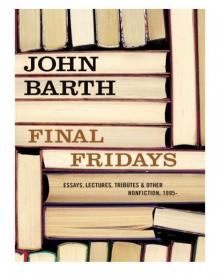 Final Fridays
Final Fridays Where Three Roads Meet: Novellas
Where Three Roads Meet: Novellas Every Third Thought: A Novel in Five Seasons
Every Third Thought: A Novel in Five Seasons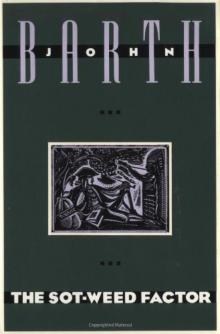 The Sot-Weed Factor
The Sot-Weed Factor The Friday Book
The Friday Book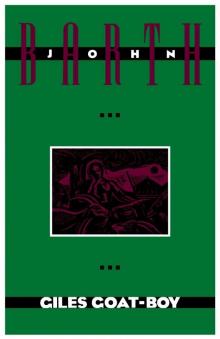 Giles Goat Boy
Giles Goat Boy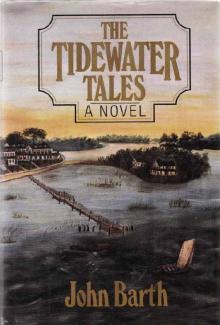 The Tidewater Tales
The Tidewater Tales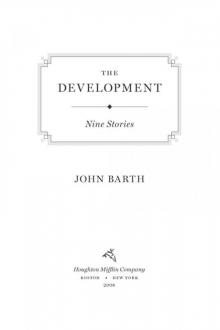 The Development
The Development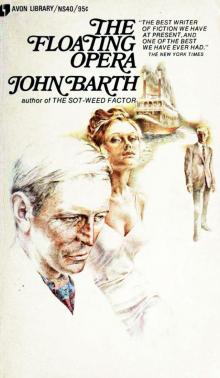 The Floating Opera
The Floating Opera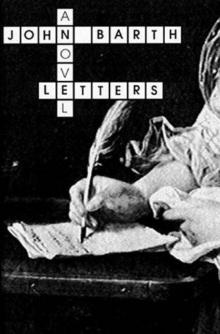 Letters
Letters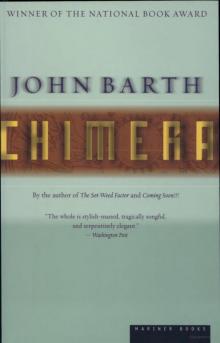 Chimera
Chimera Where Three Roads Meet
Where Three Roads Meet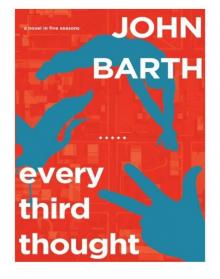 Every Third Thought
Every Third Thought